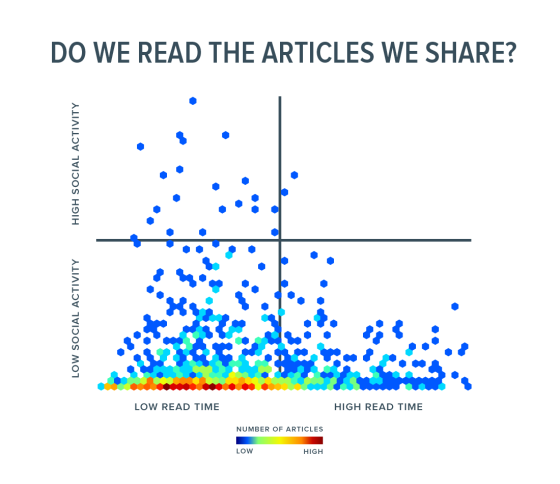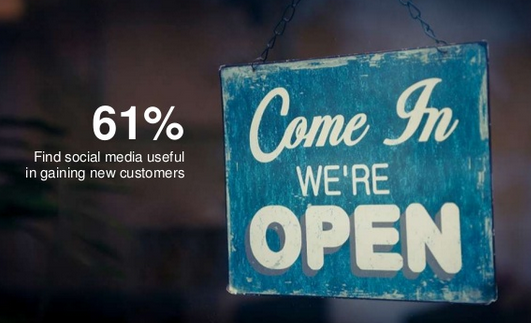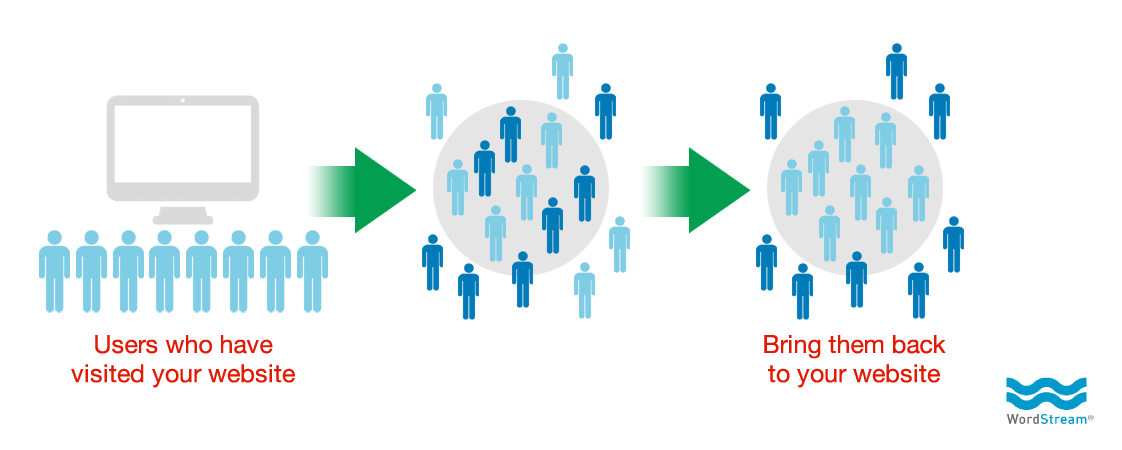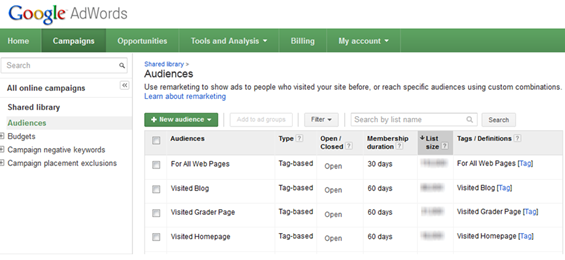
According to data by Tony Haile of Chartbeat, I’ve only got 15 seconds to capture your attention … so I guess I better make it quick. His data shows that people aren’t reading content on the web the way we think they are, and the whole measurement system might be broken. Instead of tracking article views, we should focus on reading time and page engagement.
As a person who makes a living off of people reading, clicking, and sharing content, I was initially terrified. This couldn’t possibly be true — otherwise everything I know about content is pretty much a lie! To quell my panic, I took a little closer look at the data — it seemed to be mostly from media companies.
In an email exchange, Chartbeat confirmed my suspicions. “The sample we used for our research is a random sample of the clients for whom we have permission to aggregate and anonymize their data,” said Lauryn Bennett, Head of Brand at Chartbeat. “There are blog posts and the like included in the articles but most are traditional news/media posts, as we work with mostly media sites. Also, the term “articles” doesn’t include homepages or landing pages; they’re the news/content/media posts, pages, stories.”
Even though we’re all trying to be media companies, there are times where we aren’t exact copycats. We have different business models. We have different challenges. We have different goals. We should both be working toward being like each other, but the reality is that we’re not there just yet.
So I dug through Chartbeat’s data to see what kind of takeaways folks like me who are trying to grow a business through content should know. I’ll outline the three most important data points I found in the article and then explain what that data means for anyone trying to use content to grow their business.
At this point, at least a third of you have clicked away from this post — thanks to those of you sticking around for the good stuff — so hopefully you’ll stick around a little bit longer. The data is captivating, and the insights could make you think about your job a little differently. I hope you read to the end (for both of our sakes).
Data Point #1: People Engage With Newsworthy Content More Than Evergreen Content
The Chartbeat team looked at a random sample of 2 billion pageviews generated by over a half a million articles on 2,000 sites to see which types of topics got more engagement. In an email exchange, Chartbeat defined engagement as “the amount of time, measured in seconds, that a person is actively interacting with their browser. While a user is reading a page, we count up the amount of time s/he spends with the page in an active browser tab — a foregrounded tab where the user has scrolled, typed, navigated, or moved their mouse in the last few seconds.”
According to the TIME article, “Articles that were clicked on and engaged with tended to be actual news. In August, the best performers were Obamacare, Edward Snowden, Syria and George Zimmerman, while in January the debates around Woody Allen and Richard Sherman dominated.” On the flip side, articles with little engagement were those with generic, evergreen topics. “In August, the worst performers included Top, Best, Biggest, Fictional etc. while in January the worst performers included Hairstyles, Positions, Nude and, for some reason, Virginia. That’s data for you.”
This was one of those takeaways that knocked me on my feet — after all, evergreen articles contribute a huge chunk of leads and blog post views every month. But, on a deeper look, it’s not all that surprising. If you’re just looking at single month snapshots, newsworthy content will definitely be on top — it’s still relevant. But, if I had to take a guess, this trend wouldn’t look the same if you looked at a longer period of time.
I’d bet that story traffic and engagement rates spike when it’s newsworthy, then plummets when it’s “old news.” Evergreen content, on the other hand, would be a slow growth (including engagement). I’d speculate that if you measure both types of articles over a year, their average engagement numbers would be strikingly similar. They’re two different plays — one forlongterm, sustainable growth, the other for quick splashes of traffic.
Of course, I don’t have access to the data, so this could be utter fluff, but the takeaway here should not be to double down on newsworthy content. You’re concerned with longterm, sustainable traffic to your site that converts into sustainable growth for your business — not content that brings you business one month and then trickles off. That being said, if you’re looking to reach short-term traffic and lead gen goals, trying to newsjack could help you attain them.
Data Point #2: Social Media Has Little Effect on Reading Engagement
The Chartbeat data on social media’s influence on reading engagement was also pretty dire. Out of 10,000 articles shared on social media, they found that there was no relationship whatsoever between the amount a piece of content is shared and the amount of attention an average reader will give that content. The chart below can show you want that means, visually:

Kinda dismal, right? You’d think that because social media helps businesses get traffic, leads, and customers to people’s websites, a majority of those would be engaged visitors.
So maybe you refocus your social efforts to engage only the most avid readers — if you’re a HubSpot customer using Social Inbox, you can get a better idea of who you’re talking to and where you’re spending your time. Maybe you find that leads are those who consume the most content, so you choose to spend more time sending them articles.
Or maybe you can think about the larger picture. People who come through social media to your site most likely stumble on the link randomly and something specific piques their interest. They passively found your link, so it’s no wonder that they might not be your most engaged reader.
On the other hand, people who find your content through search engines are in active search mode already — they’re looking for a specific answer and are committed to taking the time to find it, which may make them more engaged visitors. If that’s the metric you’re trying to move on your content, you should focus on more SEO optimization. This data doesn’t mean all social is hopeless — it just means you might have to rethink how you’re using those platforms and maybe reallocate your time to other marketing activities.
Data Point #3: Banner Ads Don’t Work
Chartbeat just comes out and says it: Banner ads are on the outs. “Click-through rates are now averaging less than 0.1% and you’ll hear the wordsbanner blindness thrown about with abandon,” Haile says in TIME.
But Haile offers a solution. Since 66% of attention on a normal media page is spent below the fold, and people spending at least 20 seconds on a page with an ad are 20-30% more likely to recall that ad afterwards, advertisers should just focus on placing their ads in places people look, and on getting them to look at the ads for a while.
He’s not suggesting that advertising be kicked in the pants, just that advertisers should use metrics like time and attention instead of views and clicks. And by focusing on new metrics, advertisers can get better ROI and media sites can focus on what really matters: creating quality content that gets people to stick around.
So what do these recommendations actually mean for your business? Spend more money on advertising to get better marketing ROI? Not quite.
First, I’d argue that switching up the placement of ads won’t impact reader behavior in the long run. That “banner blindness” thing is actually a studied phenomenon. According to user testing by the Nielsen Norman Group, no matter what the engagement level, people ignore banner ads. They say, “If users are looking for a quick fact, they want to get done and aren’t diverted by banners; and if users are engrossed in a story, they’re not going to look away from the content.” Which brings me to my next point — if the solution is to create quality, engaging content, banner ads could be even less effective.
Instead of buying up ads, just focus on creating your own quality content. Be the content on the page that keeps people engaged — not the ad on the side that’s either interrupting an experience or getting ignored. Get the pageviews on your site instead of renting out others’.
At the end of the day these stats give us a fascinating look into the media world — the folks we’re all trying to model our content after. We shouldn’t take every piece of data with a grain of salt, but with a little digging and extra analysis, we can walk away with some tangible takeaways for our business.
What do you think of this data? I’d love to hear your perspective in the comments.












Recent Comments